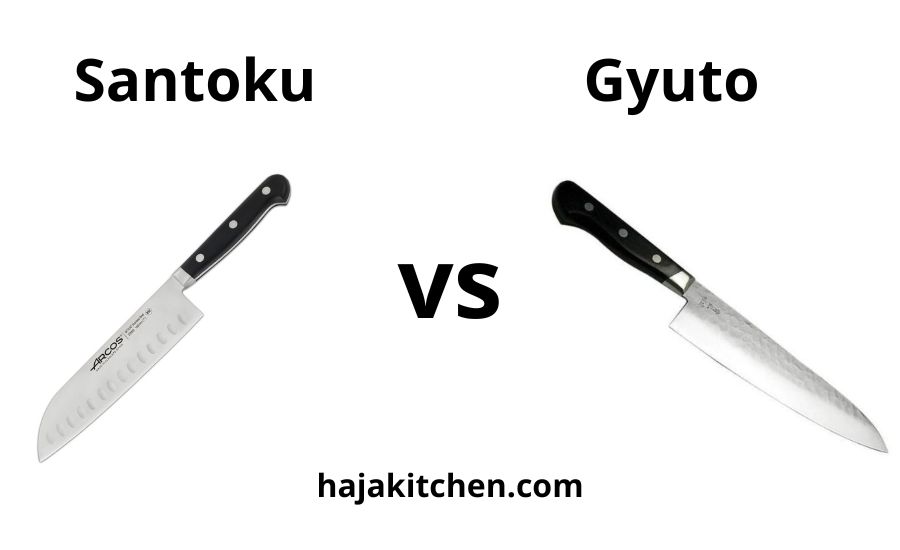You may encounter many different names for various blades in the world of Japanese knives. Upon first glance, these blades may appear to be identical, leading one to believe that they serve the same purposes.
A Santoku and a Gyuto knife can sometimes be mistaken because of their similarities. However, they are appropriate for different purposes due to a few significant distinctions.
The similarities and differences between a Gyuto and Santoku knife and which one is better for your kitchen will be discussed in this article.
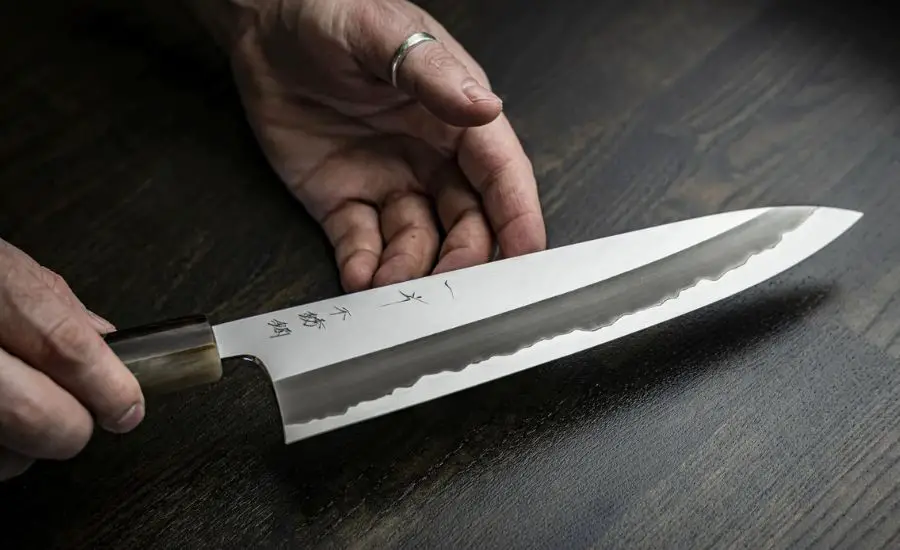
What is a Gyuto knife?
The Gyuto knife is a modern multipurpose chef’s knife. They feature a pointed tip at the end of a curving belly and a narrow profile. They resemble Western chef’s knives in terms of design. The Gyuto knife is the preferred type of Japanese knife among Western professionals.
Foreign culture started to influence every aspect of life when Japan opened to the West in the late 1800s. People started consuming poultry and beef.
This was problematic as conventional Japanese blades were made for cutting seafood and vegetables.
Due to its extreme thinness, the conventional single-bevel blade could bend and chip when slicing through muscle and sinew. The goal of Japanese blacksmiths was to create a chef knife that could cut into beef without breaking by using high-quality materials and traditional techniques.
The end product was a kitchen knife that is agile and multipurpose, and it retains its edge during most kitchen tasks. It is very proficient for rock chopping. Gyuto knives are easy for everyone to pick up and use because of their similarities to Western blades.
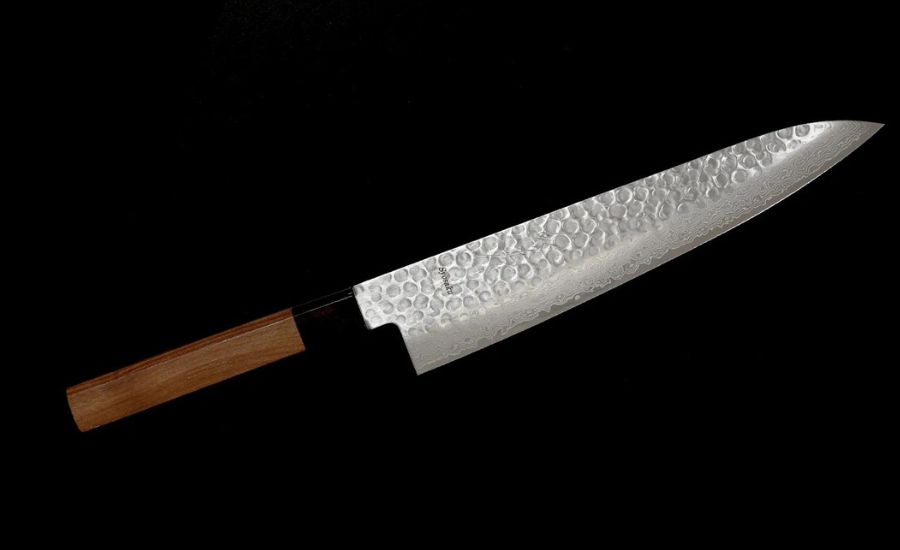
What is a Santoku knife?
In Japanese, the term “Santoku” signifies “three virtues”. There are people who think that the three virtues are methods to use a Santoku: dicing, slicing, and mincing. Other individuals believe it pertains to the things a santoku can cut, like fish, meat, and vegetables.
The Santoku knife has a slightly different blade shape. They have sheepsfoot blades. The wide curve of a sheepsfoot blade extends from the spine to the flat edge. Although sheepsfoot blades are simple to handle, they are less versatile since they do not have a sharp tip. Scoring and other delicate cutting tasks are more challenging without a sharp point.
With relatively little effort, the flat edge produces clean, accurate, and uniform cuts by enabling full contact with the cutting board. Santoku is perfect for slicing through tough vegetables since it makes full contact with the cutting board. They are substantially lighter than comparable knives and may be easily maneuvered in confined spaces thanks to their reduced blade length.
Although the designs of Sansoku and traditional cleavers are similar, they are not meat-specific knives. It can actually cut fruit and fish with ease and is excellent at chopping vegetables due to its straight blade. These are multi-purpose knives that are capable of cutting through almost anything.
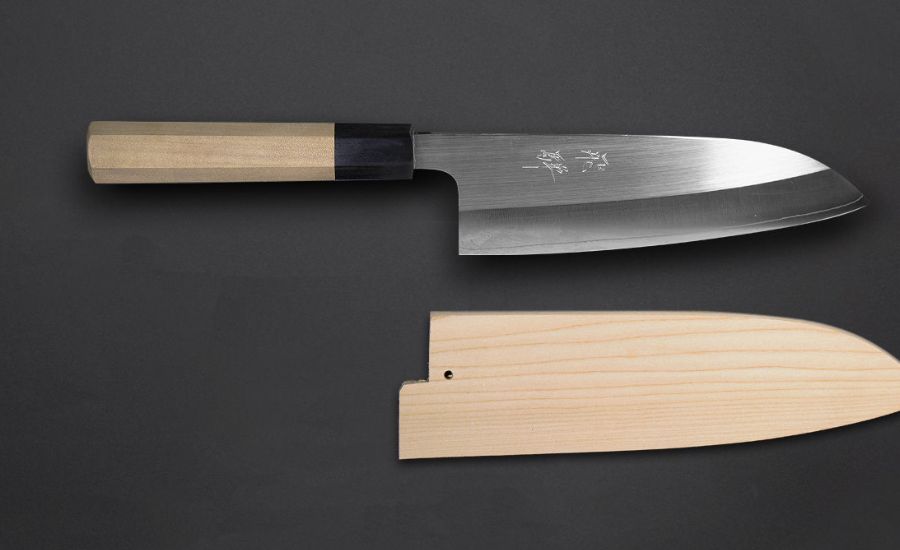
Santoku vs Gyuto: benefits and drawbacks
Benefits and drawbacks of Santoku knives
Benefits
- It is significantly lighter compared to a Gyuto knife.
- Your knife won’t require frequent sharpening because of its superior edge retention.
- It chops very quickly thanks to its hard, thin blade.
- It is perfect for precision tasks like finely dicing and slicing because of the blade’s remarkable narrowness.
- They are among the easiest blades to work with when they need to be sharpened because they don’t have bolsters to get in the way.
Drawbacks
- Self-injury is more likely with a Santoku due to the absence of a bolster.
- Certain tasks, such as cutting meat, could be trickier because of their extreme flexibility.

Benefits and drawbacks of Gyuto knives
Benefits
- These kitchen knives are thicker than Santoku knives and, therefore, much more robust and durable.
- It is also much more versatile than a Santoku knife, as it can be used for a wide range of foods, including meat, fish, vegetables, and fruits, due to its curved blade.
- These kitchen knives have a bolster, thereby making them safer.
- This chef’s knife usually comes with a thick handle that provides a better grip.
Drawbacks
- This chef’s knife feels heavier because of its thicker handle.
- You may have to sharpen this chef’s knife more regularly because they are not constructed from hard steel.
- The curved blade of this chef’s knife implies that you have less control over the cut.

Santoku vs Gyuto: similarities
You need to understand the similarities between the two knives before choosing which one is best for you. We’ll go over all of the similarities between a Gyuko and a Santoku below:
To start with, these are both versatile knives. They are capable of carrying out a wide range of tasks effectively.
Santoku and Gyuto knives are equally proficient at chopping, dicing, slicing, and mincing meat, fish, and vegetables.
Furthermore, they are both Japanese knives. Additionally, Japanese companies make the best Gyuto and Santoku knives.
These knives are made with age-old Japanese techniques that have been handed down through generations.
Premium steel is used in the construction of these Japanese blades.
Regardless of whether the steel is stainless steel or high carbon, the companies that make Santoku and Gyuto knives always use the best steel.
Moving on to the next point, the handles of these knives are constructed from premium materials like mahogany, pakkawood, and molybdenum. This enables you to grasp the knives comfortably.
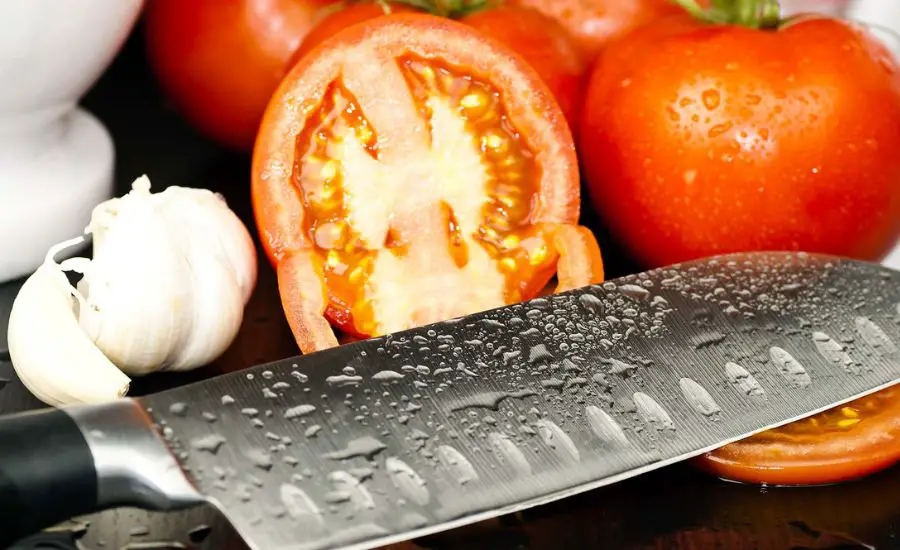
Santoku vs Gyuto: differences
While both are multipurpose knives, they stand out for different cutting tasks due to their distinct qualities. The key distinctions between Santoku and Gyuto knives are broken down in the next section.
Weight
Although the composition, design, and length all affect weight, Gyuto knives frequently weigh more than Santoku knives.
Blade shape
The design of the blade is the most noticeable distinction between Gyuto and Santoku knives. The spine of a Santoku blade is angled downward, whereas the spine of a Gyuto blade is flatter.
The flatness of the Gyuto spine and the curve of its edge allow for a sharper, better-defined point. It resembles an European chef’s knife in terms of design. A less sharp tip is produced by the downturned spine and slight curvature of the Santoku edge. It is shaped like a sheep’s hoof.
The aesthetic components of both kinds of blades frequently vary. They also have a high degree of artistry, depending on the brand.
A Granton edge is a common characteristic of a Santoku but not a Gyuto knife. The Granton edge has tiny, rounded indentations that create air pockets to repel food from the knife.
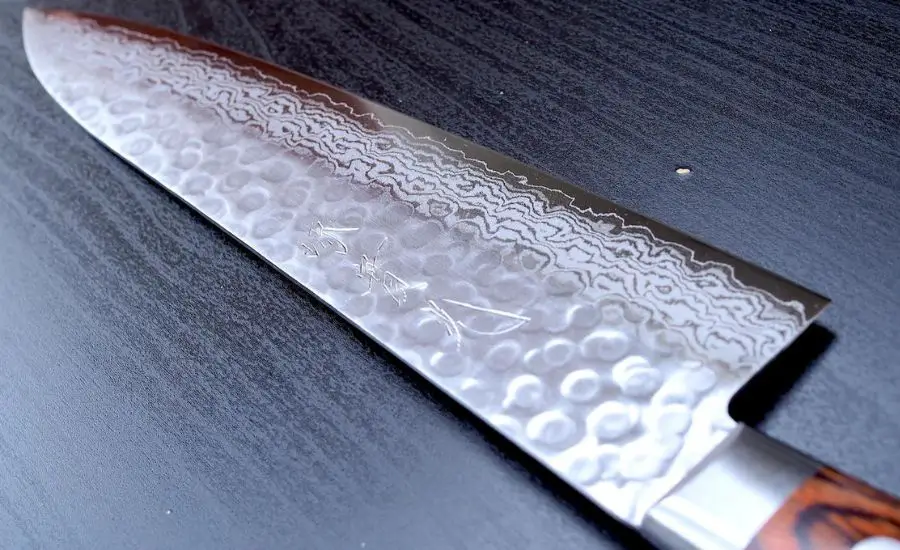
Sharpness
Although few are single-bevel, most Santoku knives are double-bevel.
Nearly every Gyuto knife is a double bevel. Single-bevel Gyuto knives are relatively rare.
Both sides of a double-bevel knife’s blade are ground and sharpened.
Single-bevel knives have a very small edge angle, which makes them chip easily despite the fact that they are extremely sharp. Because of this, all-purpose knives such as Santoku and Gyuto are typically double bevel.
Most Santoku and Gyuto knives are sharpened to an angle of no more than 15 or 16 degrees on either side. However, The brand and collection determine the exact sharpness.
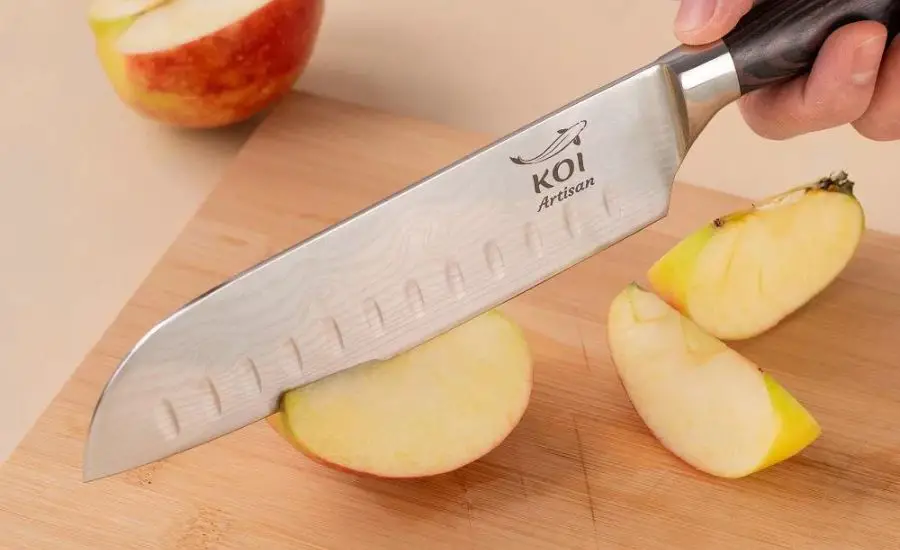
Applications
Although the purposes of both knives are quite similar, a Santoku is more suitable for push cutting, chopping, and making straight cuts, while a Gyuto is better suited for rock chopping, cutting around bones, making slits, and slicing through firm ingredients.
Price
Gyuto knives are typically a little more expensive than Santoku knives because of their longer blades. Prices rise in proportion to the amount of steel.
Materials, brands, and collections all influence price. Knives with handles made of rosewood, for instance, will sell for more money than those with handles made of plastic or synthetic material.
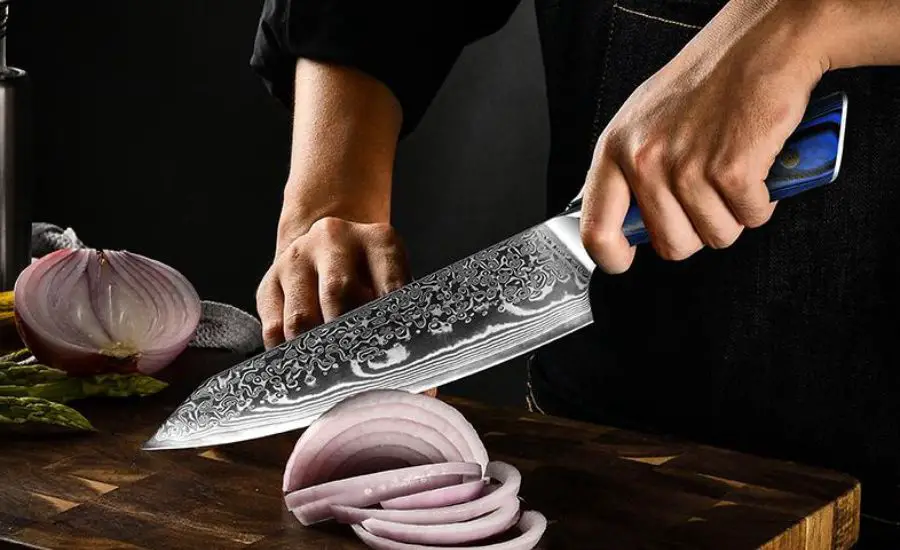
Blade length
Santoku blades are shorter compared to Gyuto blades in most cases. Both knife types do, however, have several blade lengths available.
Santoku knives typically have a seven-inch blade. However, 5-inch blades are also prevalent. A Gyuto blade is usually eight inches long, similar to a Western chef’s knife, although they can also be found in six and ten inches.

Should I get Santoku or Gyuto?
Santoku and Gyuto knives are both versatile and suitable for a wide range of culinary applications. Gyuto are marginally better all-purpose knives compared to Santoku thanks to their piercing tip and belly for rocking. However, Santoku is still effective for most culinary tasks.
Santoku blades are shorter and have a more blunted tip compared to Gyuto blades, which are longer and have a sharper tip and curved edge. Gyutos are better for meats and the rock chop method, whereas Santokus are better for veggies and straight cuts.
Do professional chefs use Santoku knives?
Most cooks are so particular about their kitchen knives that they always travel with their favorite set. It makes sense because having an exceptional knife can significantly cut down on the amount of time spent prepping food and increase kitchen efficiency. In reality, several Michelin chefs use a chef’s knife or Santoku knife for most of their food prepping.
Santoku knives are a popular choice among professional chefs due to their versatility and functionality in the kitchen. With its sharp blade, the Santoku knife can effortlessly chop, dice, and slice through a variety of ingredients with precision and control.
The flat edge of the blade ensures that each cut is clean and even, while the wide blade makes it easy to scoop and transfer ingredients. The ergonomic design and comfortable grip of this Japanese kitchen knife also make it a favorite among chefs who spend long hours in the kitchen.
What knives does Gordon Ramsay use?
World-famous chef Gordon Ramsay has become well-known for his extraordinary culinary abilities. His selection of knives is one of the factors contributing to his success.
Ramsay is known for his preference for high-quality Japanese knives that are sharp, precise, and durable. In particular, he uses knives from the German brands Wüsthof and Henckels, which are known for their high-quality and long-lasting performance.
Ramsay possesses a selection of Japanese knives, including Gyuto and Santoku models from companies like Global and Shun. Because of their precise and accurate design, these knives are the perfect equipment for a skilled chef such as Ramsay.
Santoku knives are known for their versatility and are ideal for chopping, slicing, and mincing, while Gyuto knives are designed for slicing through meat and poultry with ease.
In addition to his collection of knives, Ramsay also favors knives that have a full tang. This results in a solid and well-balanced grip since the blade goes all the way through the handle. Additionally, he favors knives with a comfortable handle because it makes them easier to hold and less tiring to use for extended periods.
All things considered, one of the main reasons Ramsay has been such a successful chef is his fondness for fine, accurate, and sharp knives. With the help of his assortment of knives from German and Japanese knife manufacturers, he can easily and precisely prepare outstanding dishes.
Can you use a Santoku knife for everything?
YES. A Santoku knife is a versatile knife that may be used for dicing, slicing, and chopping. These tasks are the cornerstones of any knife work and the basic components of nearly every dish.
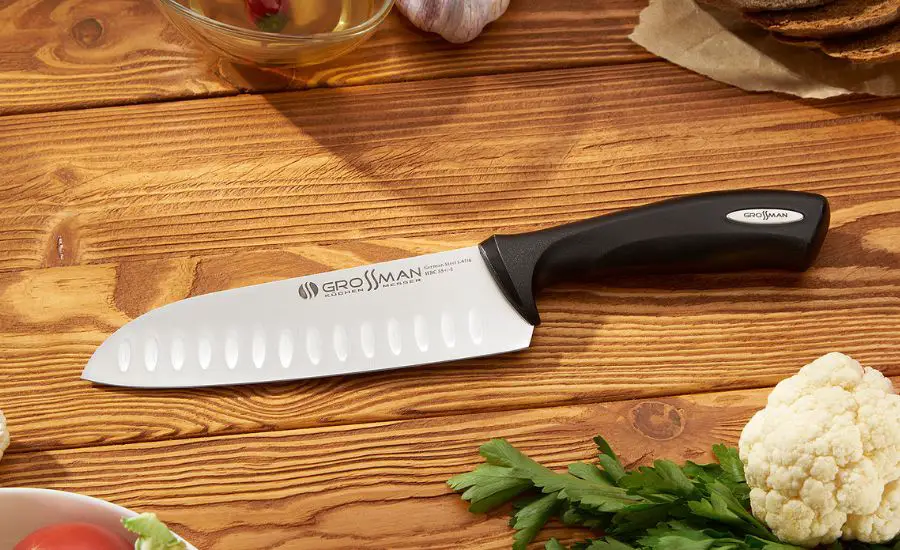
Conclusion: Santoku vs Gyuto
It’s common for people to be confused about which of the two Japanese knives to choose. Aside from the variations in tip shape and the blade’s curve, they slightly resemble each other. Furthermore, it could be challenging to decide between them because they are both multi purpose knives.
Which one should you purchase? Gyuto or Santoku knife? A Gyuto is one knife that’s typically more versatile compared to a Santoku. Having said that, the Santoku is better for making straight cuts. Since each of these blades has advantages and disadvantages of their own, it really comes down to personal preference and intended application.

